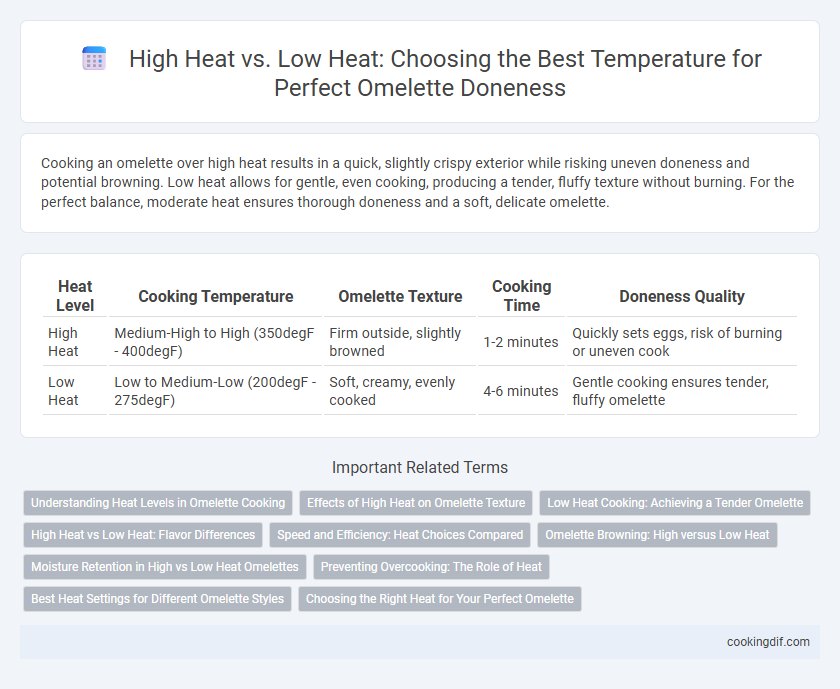Cooking an omelette over high heat results in a quick, slightly crispy exterior while risking uneven doneness and potential browning. Low heat allows for gentle, even cooking, producing a tender, fluffy texture without burning. For the perfect balance, moderate heat ensures thorough doneness and a soft, delicate omelette.
Table of Comparison
| Heat Level | Cooking Temperature | Omelette Texture | Cooking Time | Doneness Quality |
|---|---|---|---|---|
| High Heat | Medium-High to High (350degF - 400degF) | Firm outside, slightly browned | 1-2 minutes | Quickly sets eggs, risk of burning or uneven cook |
| Low Heat | Low to Medium-Low (200degF - 275degF) | Soft, creamy, evenly cooked | 4-6 minutes | Gentle cooking ensures tender, fluffy omelette |
Understanding Heat Levels in Omelette Cooking
Cooking an omelette on high heat causes rapid protein coagulation, creating a firmer texture but increasing the risk of browning and uneven cooking. Low heat allows gentle heat penetration, resulting in a tender, creamy interior and uniform doneness by preventing overcooking. Understanding the heat levels optimizes texture and flavor, as medium-low heat is often ideal for balancing thorough cooking with soft, delicate curds.
Effects of High Heat on Omelette Texture
High heat cooking causes an omelette to brown quickly while creating a crispy exterior but may result in a rubbery texture and uneven doneness inside. Rapid coagulation of proteins under high heat often leads to a tough, less tender omelette compared to gentle cooking methods. Achieving a balanced texture requires careful heat control to avoid overcooking or burning the egg mixture.
Low Heat Cooking: Achieving a Tender Omelette
Cooking an omelette on low heat ensures gentle, even cooking that preserves a tender, creamy texture while preventing browning or rubberiness. Maintaining a low temperature allows the eggs to coagulate slowly, resulting in a smooth, custard-like consistency ideal for delicate fillings such as cheese, herbs, or vegetables. This technique enhances flavor development and yields a perfectly soft omelette with a melt-in-the-mouth finish.
High Heat vs Low Heat: Flavor Differences
High heat cooking develops a rich, slightly crispy exterior on an omelette due to Maillard reactions, intensifying its savory flavor. Low heat cooking produces a tender, creamy texture, preserving delicate egg flavors and subtle sweetness. Choosing between high and low heat impacts the omelette's taste profile by balancing caramelization with softness.
Speed and Efficiency: Heat Choices Compared
Cooking an omelette on high heat significantly reduces cooking time, allowing for quick preparation but risks uneven doneness or browning. Low heat provides more control over texture and consistency, producing a tender, evenly cooked omelette, though it requires a longer cooking duration. Balancing heat intensity ensures optimal speed and efficiency while achieving the desired omelette quality.
Omelette Browning: High versus Low Heat
Cooking an omelette over high heat causes rapid browning due to the Maillard reaction, resulting in a firmer texture and a golden crust. Low heat cooking allows for gentle coagulation of eggs, producing a tender, evenly cooked omelette with minimal browning. Controlling heat level directly influences the omelette's color, texture, and moisture retention.
Moisture Retention in High vs Low Heat Omelettes
Cooking an omelette on low heat promotes better moisture retention, yielding a tender and creamy texture by gently coagulating the proteins without excessive water evaporation. High heat causes rapid protein coagulation and moisture loss, resulting in a drier, firmer omelette with a more rubbery texture. Optimal omelette doneness balances heat and cooking time to maintain juiciness and prevent over-drying.
Preventing Overcooking: The Role of Heat
Cooking an omelette requires precise heat control to prevent overcooking and maintain a tender texture. Using low to medium heat allows the eggs to cook evenly without becoming rubbery or dry, preserving moisture and flavor. High heat often leads to rapid cooking, causing the omelette to brown too quickly on the outside while remaining undercooked inside, resulting in a tough and less appetizing dish.
Best Heat Settings for Different Omelette Styles
Cooking an omelette on high heat rapidly sets the eggs, creating a crispy exterior ideal for French-style omelettes that are tender and slightly runny inside. Low heat allows gentle cooking, preserving a creamy texture perfect for American or Denver omelettes with fillings that need thorough warming without burning. Adjusting heat settings ensures optimal doneness: high heat for quick, firm edges and low heat for soft, evenly cooked layers.
Choosing the Right Heat for Your Perfect Omelette
Choosing the right heat is critical for crafting a perfect omelette, with low heat offering gentle cooking that ensures a tender, evenly cooked interior without browning or toughness. High heat swiftly cooks the eggs, creating a firmer texture and a slightly crisp edge but risks burning or undercooking the center if not closely monitored. Mastering the balance between low and high heat techniques allows for control over doneness, texture, and flavor, producing an omelette that is fluffy and moist or firm and golden depending on personal preference.
High Heat vs Low Heat for omelette doneness Infographic

 cookingdif.com
cookingdif.com